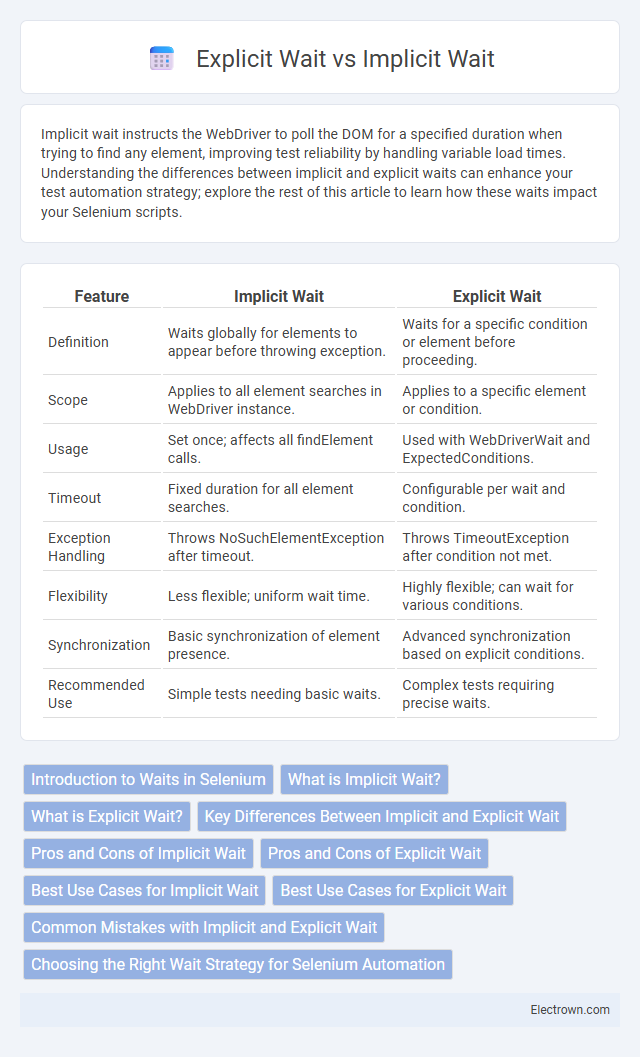Implicit wait instructs the WebDriver to poll the DOM for a specified duration when trying to find any element, improving test reliability by handling variable load times. Understanding the differences between implicit and explicit waits can enhance your test automation strategy; explore the rest of this article to learn how these waits impact your Selenium scripts.
Table of Comparison
| Feature | Implicit Wait | Explicit Wait |
|---|---|---|
| Definition | Waits globally for elements to appear before throwing exception. | Waits for a specific condition or element before proceeding. |
| Scope | Applies to all element searches in WebDriver instance. | Applies to a specific element or condition. |
| Usage | Set once; affects all findElement calls. | Used with WebDriverWait and ExpectedConditions. |
| Timeout | Fixed duration for all element searches. | Configurable per wait and condition. |
| Exception Handling | Throws NoSuchElementException after timeout. | Throws TimeoutException after condition not met. |
| Flexibility | Less flexible; uniform wait time. | Highly flexible; can wait for various conditions. |
| Synchronization | Basic synchronization of element presence. | Advanced synchronization based on explicit conditions. |
| Recommended Use | Simple tests needing basic waits. | Complex tests requiring precise waits. |
Introduction to Waits in Selenium
Selenium uses waits to manage synchronization issues between the web driver and web elements, improving test reliability. Implicit Wait instructs the driver to poll the DOM for a specified time when trying to find an element, applying globally to all web elements. Explicit Wait allows you to define specific conditions and timeouts for targeted elements, providing more precise control over dynamic web page interactions.
What is Implicit Wait?
Implicit Wait in Selenium WebDriver is a global setting that instructs the driver to poll the DOM for a specified amount of time when trying to locate an element before throwing a NoSuchElementException. This wait applies to all elements and is set once per session, helping to manage element load times efficiently by reducing the need for explicit waits scattered throughout the test code. Its primary function is to provide a default waiting time for the entire driver instance, enhancing test stability with minimal code changes.
What is Explicit Wait?
Explicit Wait in Selenium WebDriver is a programmatic wait that pauses the execution until a specific condition is met or a maximum timeout is reached. It targets particular elements with conditions like visibility, clickability, or presence, improving test reliability by handling dynamic web content. Unlike Implicit Wait, Explicit Wait provides greater control by allowing specific wait conditions and exceptions management for element synchronization.
Key Differences Between Implicit and Explicit Wait
Implicit Wait in Selenium sets a default polling period to locate elements, causing the WebDriver to wait globally before throwing a NoSuchElementException. Explicit Wait targets specific elements or conditions, using ExpectedConditions to pause execution until those criteria are met or a timeout occurs. The main difference lies in scope and control: Implicit Wait applies universally across the test session, while Explicit Wait allows fine-grained synchronization for particular elements or events.
Pros and Cons of Implicit Wait
Implicit Wait automatically pauses your WebDriver for a set time when searching for elements, reducing the likelihood of NoSuchElementExceptions in dynamic web pages. It simplifies test scripts by applying globally, but this can lead to longer wait times and reduced test performance if elements appear quickly. Implicit Wait is less flexible than Explicit Wait, as it cannot target specific elements or conditions, which might decrease the efficiency of your Selenium tests.
Pros and Cons of Explicit Wait
Explicit wait in Selenium WebDriver allows for waiting until a specific condition is met, offering precise control over synchronization, which reduces test flakiness and improves reliability. It is advantageous for handling dynamic web elements that load at different speeds, but overuse can lead to increased test execution time and complexity. The main drawback of explicit wait is its dependency on correctly defined ExpectedConditions; improper use can cause either premature timeout or unnecessary delays.
Best Use Cases for Implicit Wait
Implicit Wait is best used when you want to set a default waiting time globally for all elements in your Selenium WebDriver scripts, ensuring that the driver polls the DOM for a specified duration before throwing a NoSuchElementException. It is highly effective in scenarios where elements load asynchronously but the wait time is relatively uniform across the application, minimizing code complexity. Your automation will benefit from implicit waits in straightforward, stable environments where dynamic content delays are predictable.
Best Use Cases for Explicit Wait
Explicit Wait is best used when specific conditions must be met before interacting with web elements, such as waiting for an element to become clickable or visible in dynamic web applications. It offers precise control by waiting for defined states like element presence, visibility, text changes, or alerts, which is essential in handling AJAX and JavaScript-heavy pages. This targeted waiting approach improves test reliability and efficiency by avoiding unnecessary delays compared to Implicit Wait.
Common Mistakes with Implicit and Explicit Wait
Common mistakes with implicit wait include setting it globally for long durations, causing unnecessary delays and masking synchronization issues. Explicit wait is often misused by relying on overly generic conditions or failing to handle exceptions like TimeoutException properly, leading to flaky tests. Combining implicit and explicit waits can cause unpredictable wait times and should be avoided to maintain efficient and reliable test execution.
Choosing the Right Wait Strategy for Selenium Automation
Choosing the right wait strategy in Selenium automation depends on the specific scenario and element behavior. Implicit Wait applies a universal delay to all element searches, making it suitable for consistent load times, while Explicit Wait targets specific elements with custom conditions, enhancing precision and reducing test flakiness. Your choice between these waits should align with the application's responsiveness and the reliability requirements of your test scripts.
Implicit Wait vs Explicit Wait Infographic

 electrown.com
electrown.com